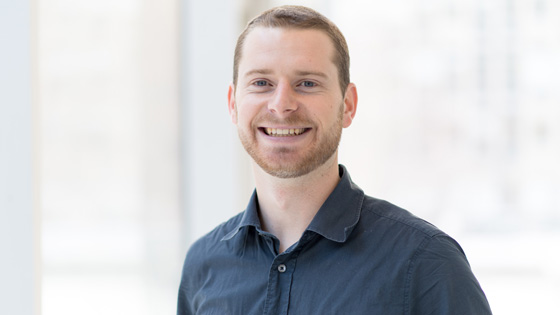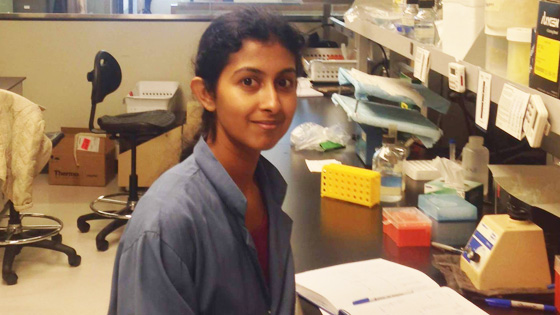
Eric Gracey was once a patient with spondylitis, now he is researching his own disease with the hope of finding more personalized treatments for men and women.
(Photo: Toronto Western Research Institute)
Eric Gracey is driven to find out what causes the body's immune system to do "crazy things" when it is affected by ankylosing spondylitis (AS), a severe form of arthritis.
Little wonder. Before he began researching AS, he was nearly a patient.
Eric was in his early 20s when he was diagnosed with undifferentiated spondylitis. For six months, he could barely walk. Doctors didn't have a way of predicting whether or not his condition would progress to the more severe AS, or if the medication they were prescribing would have much effect.
FAST FACTS ABOUT ANKLYOSING SPONDYLITIS
- Affects upwards of 300,000 Canadians
- Symptoms often begin between the ages of 15 -30
- About 30 percent of people with AS will develop iritis (eye inflammation)
- Experts at Toronto Western Hospital led a ground-breaking, international study that showed biologics can stop the progression of AS and relieve symptoms
Being a young male and with a family history of spondylitis, there was a significant risk that his condition could get worse.
Luckily, Eric's symptoms faded over time. Today, he runs marathons and is pursuing a PhD in immunology.
Painful condition
AS is a type of arthritis and is caused when the immune system becomes overactive and attacks the joints of the spine and pelvis. Inflammation is succeeded by fusion of the joints of the spine resulting in a painful condition that causes the spine to permanently curve.
Working under the leadership of Drs. Robert Inman and Nigil Haroon, co-directors of the UHN Spondylitis Program, Eric and research colleague Dr. Vidya Ranganathan are presenting their latest findings today at the International Genetics of Ankylosing Spondylitis (IGAS) Consortium.
IGAS brings together experts from around the world to further understand the role of genetics in AS, as well as to find ways to better diagnose and treat this inflammatory disease. Previous IGAS meetings have been held in Oxford, Houston and Shanghai.
'An honour'
This is the first time Canada is playing host to the meeting, with Drs. Inman and Haroon serving as directors.
"It is an honour to host this conference in Toronto, a major hub for treatment and research in AS," says Dr. Haroon. "The majority of AS patients carry the gene HLA-B27, but having the gene doesn't mean you will have AS – we need to find out what other factors are needed to turn on the disease."
Eric's research is focused on Th 17 cells, which play a role in causing inflammation. He wanted to know if these cells behaved differently in men and women, since men have a much higher incidence of AS – about three times more than women. Because Toronto Western Hospital has one of the largest AS programs in North America, there is a large enough pool of patient data to be able to compare males to females.
Eric's research has revealed that males have more active Th 17 cells. This new knowledge could lead to a more personalized approach to treatment that targets these cells and provide an answer as to why males are more predisposed to the disease.

Dr. Vidya Ranganathan research is focused on a molecule that is involved with bone formation – her research could lead to a way to diagnose Ankylosing Spondylitis earlier. (Photo: Toronto Western Research Institute)
Dr. Ranganathan research looks at AS from a slightly different perspective, as she tries to crack the mystery of how inflammation leads to unnecessary bone growth and causes the spine to fuse together.
She is looking at a particular molecule called Macrophage Migration Inhibitory Factor (MIF) that is involved in bone formation. Higher levels of MIF are found in AS patients and as a result, when researchers look how much MIF is present in the blood the more that is there, the more severe the disease.
If Dr. Ranganathan can determine that MIF does indeed play a role in the progression of the disease, then this could be a potential target for therapy (using drugs to block MIF and therefore control the bone formation that fuses the spine together). This research could also improve our ability to diagnose the disease earlier than is now possible, by detecting MIF levels at an early stage.
"Right now we rely heavily on X-ray, CT and MRI scans to diagnose AS," says Dr. Inman. "But by the time we can see it, it can be quite advanced – the earlier we can detect it and start effective treatment the better chance we have of stopping this disease in its tracks."
